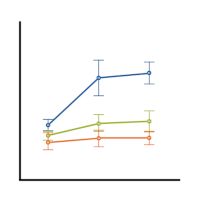 In many research fields, a common practice is to categorize continuous predictor variables so they work in an ANOVA. This is often done with median splits. This is a way of splitting the sample into two categories: the “high” values above the median and the “low” values below the median.
In many research fields, a common practice is to categorize continuous predictor variables so they work in an ANOVA. This is often done with median splits. This is a way of splitting the sample into two categories: the “high” values above the median and the “low” values below the median.
Reasons Not to Categorize a Continuous Predictor
There are many reasons why this isn’t such a good idea: (more…)
I’ve talked a bit about the arbitrary nature of median splits and all the information they just throw away.
But I have found that as a data analyst, it is incredibly freeing to be able to choose whether to make a variable continuous or categorical and to make the switch easily. Essentially, this means you need to be (more…)
 I was recently asked about whether it’s okay to treat a likert scale as continuous as a predictor in a regression model. Here’s my reply. In the question, the researcher asked about logistic regression, but the same answer applies to all regression models.
I was recently asked about whether it’s okay to treat a likert scale as continuous as a predictor in a regression model. Here’s my reply. In the question, the researcher asked about logistic regression, but the same answer applies to all regression models.
1. There is a difference between a likert scale item (a single 1-7 scale, eg.) and a full likert scale , which is composed of multiple items. If it is a full likert scale, with a combination of multiple items, go ahead and treat it as numerical. (more…)
 The way to follow up on a significant two-way interaction between two categorical variables is to check the simple effects. Most of the time the simple effects tests give a very clear picture about the interaction. Every so often, however, you have a significant interaction, but no significant simple effects. It is not a logical impossibility. They are testing two different, but related hypotheses.
The way to follow up on a significant two-way interaction between two categorical variables is to check the simple effects. Most of the time the simple effects tests give a very clear picture about the interaction. Every so often, however, you have a significant interaction, but no significant simple effects. It is not a logical impossibility. They are testing two different, but related hypotheses.
Assume your two independent variables are A and B. Each has two values: 1 and 2. The interaction is testing if A1 – B1 = A2 – B2 (the null hypothesis). The simple effects are testing whether A1-B1=0 and A2-B2=0 (null) or not.
If you have a crossover interaction, you can have A1-B1 slightly positive and A2-B2 slightly negative. While neither is significantly different from 0, they are significantly different from each other.
And it is highly useful for answering many research questions to know if the differences in the means in one condition equal the differences in the means for the other. It might be true that it’s not testing a hypothesis you’re interested in, but in many studies, all the interesting effects are in the interactions.
Here’s a little reminder for those of you checking assumptions in regression and ANOVA:
The assumptions of normality and homogeneity of variance for linear models are not about Y, the dependent variable. (If you think I’m either stupid, crazy, or just plain nit-picking, read on. This distinction really is important). (more…)
I often hear concern about the non-normal distributions of independent variables in regression models, and I am here to ease your mind.
There are NO assumptions in any linear model about the distribution of the independent variables. Yes, you only get meaningful parameter estimates from nominal (unordered categories) or numerical (continuous or discrete) independent variables. But no, the model makes no assumptions about them. They do not need to be normally distributed or continuous.
It is useful, however, to understand the distribution of predictor variables to find influential outliers or concentrated values. A highly skewed independent variable may be made more symmetric with a transformation.
 In many research fields, a common practice is to categorize continuous predictor variables so they work in an ANOVA. This is often done with median splits. This is a way of splitting the sample into two categories: the “high” values above the median and the “low” values below the median.
In many research fields, a common practice is to categorize continuous predictor variables so they work in an ANOVA. This is often done with median splits. This is a way of splitting the sample into two categories: the “high” values above the median and the “low” values below the median.
